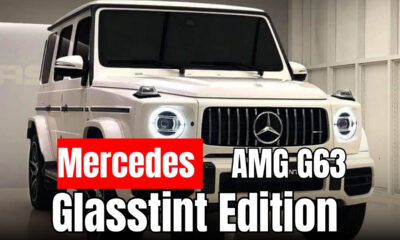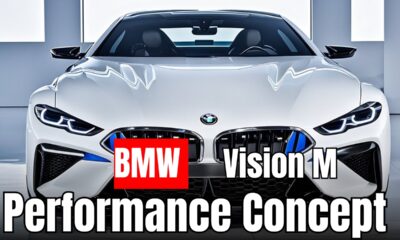Sports
CyberCab | The Future of Urban Autonomous Mobility

CyberCab is a concept or emerging product in the field of autonomous electric vehicles (AEVs), specifically designed as a robotaxi or autonomous ride-hailing solution. It integrates cutting-edge AI, electric propulsion, and smart city compatibility, with the goal of transforming how people commute in densely populated urban environments. CyberCab is typically envisioned by mobility startups, tech companies, or car manufacturers as a driverless, connected, and sustainable alternative to traditional taxis.
Key Features and Capabilities
| Feature | Details |
|---|---|
| Powertrain | Fully electric, zero-emission |
| Autonomous Driving | Level 4 or 5 autonomy (fully driverless in most cases) |
| Battery Range | Estimated 300–500 km on a single charge |
| Charging Time | Fast charging support (up to 80% in 30–40 mins) |
| Seating Capacity | 2 to 4 passengers depending on design |
| Drive System | AI-powered navigation, route optimization, V2X tech |
Design and Cabin Experience
- Futuristic Exterior: Sleek pod-style or capsule-like shape with LED lighting
- Spacious Interior: Open cabin with no steering wheel or pedals
- Smart Controls: Touch panels, voice assistant, and app-based access
- Privacy Options: Adjustable glass opacity and noise isolation features
- Accessibility: Wheelchair-friendly design in some versions
Technology and AI Integration
- Autonomous Navigation: Equipped with Lidar, radar, GPS, and cameras
- Vehicle-to-Everything (V2X): Communicates with traffic lights and other vehicles
- OTA Updates: Software can be updated remotely to improve performance
- Passenger Safety: AI monitors cabin activity and ensures safety protocols
- Cloud-Based Fleet Management: Enables real-time route optimization
Sustainability Aspects
- Electric Power Only: Reduces carbon emissions and urban air pollution
- Recyclable Materials: Interior made from eco-friendly and sustainable materials
- Efficient Use: Operates on-demand, reducing vehicle idle time and energy waste
Use Cases and Deployment
- Urban Ride-Hailing: On-demand transport in smart cities
- First-Mile/Last-Mile Connectivity: Complements public transit systems
- Airport Shuttles or Campus Mobility: For closed-loop routes
- Shared Mobility: Configured for individual or pooled rides
CyberCab vs Traditional Taxis
| Aspect | CyberCab | Traditional Taxi |
|---|---|---|
| Driver | Fully autonomous (no driver) | Human driver |
| Fuel Source | Electric | Petrol/Diesel/Gas |
| Navigation | AI & sensor-based | GPS and manual driving |
| Operating Cost | Lower (no driver salary, energy efficient) | Higher |
| Maintenance | Predictive and digital | Manual and scheduled |
| Safety | Real-time monitoring & AI decisions | Human reflexes only |
Expected Launch & Development
CyberCab is still in development or pilot testing in selected smart cities. Companies like Waymo, Zoox, Cruise, and others have working prototypes or early fleets being tested in real-world conditions. Full-scale deployment depends on regulatory approvals and urban infrastructure readiness.
Conclusion
CyberCab represents the next evolution in urban mobility, offering a cleaner, safer, and smarter way to travel. With autonomous technology, electric power, and intelligent routing, it is poised to become an essential component of future smart cities. Designed to reduce congestion, lower emissions, and improve accessibility, CyberCab is not just a vehicle — it is a platform for reimagining public transport.
Education
YouTube’s Journey! | How It Changed the Internet Forever.

In the early days of the internet, sharing videos with the world was not as seamless as it is today. That all changed with the launch of YouTube in 2005. What started as a small startup founded by three ex-PayPal employees became a revolutionary platform that has defined how modern media works. From viral videos and music sensations to independent creators and global influencers, YouTube has played a central role in democratizing content creation and changing the media landscape.
This blog takes a deep dive into YouTube’s journey — its inception, key turning points, innovations, and lasting cultural impact.
YouTube’s Evolution Over the Years
| Year | Milestone | Significance |
|---|---|---|
| 2005 | Founded by Chad Hurley, Steve Chen, and Jawed Karim | Launched with the aim to make video sharing simple for everyone |
| 2006 | Acquired by Google for $1.65 billion | Massive resources and technical support accelerated platform growth |
| 2009 | Introduction of HD video support | Improved user experience with high-quality content |
| 2010 | Mobile streaming & app improvements | Ushered in an era of on-the-go content consumption |
| 2015 | Launch of YouTube Red (now Premium) | Introduced ad-free viewing and original programming |
| 2018 | Creator monetization and Super Chat features | Gave creators new ways to earn revenue and connect with fans |
| 2020 | YouTube Shorts launched | Entered the short-form content market to rival TikTok |
| 2023+ | Enhanced AI recommendations, auto-chapters, and better analytics | Optimized creator tools and user personalization |
Key Drivers Behind YouTube’s Global Success
1. Openness to Creators of All Levels
One of the strongest features of YouTube is its open-door policy for creators. Whether you’re a student, chef, tech expert, musician, or comedian — the platform gives everyone an equal chance to be seen and heard.
2. Early Monetization Model
In 2007, YouTube introduced the Partner Program, allowing creators to earn money through ad revenue. This attracted serious content makers and turned casual uploaders into full-time YouTubers.
3. Sophisticated Recommendation Algorithms
YouTube’s recommendation engine is among the most powerful in the world. It curates personalized content for each user, keeping people engaged longer and helping creators grow their audience organically.
4. Community Engagement Tools
With features like comments, likes, polls, live chat, and memberships, YouTube supports interactive communities where creators and fans can bond directly.
5. Localization and Global Expansion
With versions available in over 100 countries and 80+ languages, YouTube is localized for global relevance. This approach has helped it become a go-to platform not only in the West but also in countries like India, Brazil, and Indonesia.
Cultural, Economic, and Social Impact of YouTube
YouTube has redefined not only entertainment but also education, business, and activism. Educational creators like Khan Academy and CrashCourse offer free learning. Entrepreneurs use it to launch brands. Activists reach global audiences with critical social messages. Musicians like Justin Bieber got their start here. Traditional media outlets have had to evolve in response to YouTube’s rise.
The platform has also introduced a new class of digital influencers — YouTubers — who command massive fanbases, brand deals, and media coverage. In many ways, YouTube has democratized fame.
Conclusion
The journey of YouTube is a testament to how technology can change the world. What started as a place to share home videos is now a global force shaping the way we learn, entertain, advertise, and even communicate. As it continues to expand into new territories like short-form content, livestreaming, AI-generated captions, and VR experiences, YouTube remains not just a platform — but a cultural phenomenon.
Its influence is undeniable, and its journey is far from over.
Sports
The All | New Shelby GT70 | The Beast Reborn in Modern Armor

| The Shelby GT70 is a bold and futuristic interpretation of American muscle. With its sleek red-black aerodynamic body, powerful supercharged V8 engine, and advanced tech integrations, this car is built for thrill-seekers and collectors alike. It combines the soul of classic muscle with modern engineering excellence. |
Exterior & Design
| Feature | Detail |
|---|---|
| Color | Glossy Red with Black Racing Stripes |
| Body Type | Widebody Coupe |
| Front Design | Aerodynamic splitter bumper with LED signature DRLs |
| Wheels | Matte Black Multi-Spoke Alloys |
| Shelby Emblem | Front grille cobra badge |
| Doors | Two-door coupe |
| Spoiler | Carbon Fiber Adjustable Rear Wing |
Performance Specifications
| Specification | Detail |
|---|---|
| Engine Type | 5.2L Supercharged V8 |
| Horsepower | 760+ HP |
| Torque | 625 lb-ft |
| Transmission | 7-Speed Dual-Clutch Automatic |
| 0–100 km/h | 3.5 Seconds (Approx.) |
| Top Speed | 300+ km/h |
| Exhaust System | Quad Active Exhaust |
| Drive Type | Rear-Wheel Drive (RWD) |
| Suspension | Adaptive MagneRide System |
Interior & Technology
| Feature | Detail |
|---|---|
| Seats | Leather + Alcantara Racing Seats |
| Dashboard Display | Digital Instrument Cluster |
| Infotainment | 12” Touchscreen, Apple CarPlay, Android Auto |
| Sound System | Premium Surround Sound |
| Connectivity | Bluetooth 5.0, Wi-Fi, USB-C |
| Controls | Voice Command, Steering Mounted Controls |
Safety & Assistance
| Feature | Detail |
|---|---|
| Traction Control | Advanced Electronic Stability System |
| Brakes | Brembo Performance Brakes |
| Camera | Rear-View with Sensors |
| Driver Assist | Lane-Keep Assist, Collision Warning |
| Airbags | Dual Front + Side Curtain Airbags |
Special Features
| Feature | Detail |
|---|---|
| Edition | Limited Production Model |
| Badging | Laser-Engraved GT70 Number Plate |
| Aerodynamics | Real Carbon Fiber Front Splitter & Rear Diffuser |
| Track Mode | Built-In Drive Modes for Racing Conditions |
Sports
Range Rover Velar | The Modern Statement of Luxury and Precision

The Range Rover Velar is the epitome of modern luxury and innovation. Crafted with a minimalist design philosophy, this premium SUV strikes a perfect balance between sophistication and strength. Its sleek silhouette, flush door handles, and floating roof design make it instantly recognizable, while its advanced performance ensures a smooth and powerful drive every time.
Inside the Velar, you’re welcomed by a refined and tech-forward cabin. From premium leather seats to dual touchscreen infotainment displays, every element is tailored for a seamless, luxurious experience. Whether you’re navigating busy city streets or embarking on long highway journeys, the Velar adapts with intelligent features like adaptive dynamics, air suspension, and all-wheel drive.
Overview
| Feature | Details |
|---|---|
| Model Name | Range Rover Velar |
| Body Style | Mid-size Luxury SUV |
| Manufacturer | Land Rover (a division of Jaguar Land Rover) |
| Segment | Premium / Luxury SUV |
| Drive Type | All-Wheel Drive (AWD) |
| Transmission | 8-Speed Automatic |
Engine Options & Performance
| Engine Variant | Engine Type | Power Output | 0-100 km/h | Fuel Type |
|---|---|---|---|---|
| P250 | 2.0L Turbocharged I4 Petrol | 247 hp | 7.1 sec | Petrol |
| P400 | 3.0L Inline-6 Mild-Hybrid | 395 hp | 5.5 sec | Petrol |
| D200 | 2.0L Turbocharged I4 Diesel | 201 hp | 8.2 sec | Diesel |
Exterior Features
| Feature | Description |
|---|---|
| Headlights | Matrix LED with Signature DRL |
| Wheels | 20″ to 22″ Black Alloy Wheels (Optional Finishes) |
| Door Handles | Flush Deployable Door Handles |
| Roof | Floating Roof Design |
| Grille | Gloss Black Grille with Satin Frame |
Interior Features
| Feature | Description |
|---|---|
| Seating | Premium Leather Upholstery |
| Dashboard | Dual Touchscreen (Pivi Pro Interface) |
| Sound System | Meridian Surround Sound System |
| Ambient Lighting | Configurable Interior Ambient Light |
| Air Quality | Cabin Air Purification with PM2.5 Filter |
| Climate Control | Dual-Zone Automatic Climate Control |
Technology & Connectivity
| Feature | Description |
|---|---|
| Infotainment | Pivi Pro with 10” Dual Touchscreens |
| Smartphone Integration | Wireless Apple CarPlay & Android Auto |
| Navigation | Online Navigation with Real-time Traffic |
| Charging | Wireless Phone Charging Pad |
| Voice Commands | Natural Voice Recognition |
| Driver Display | 12.3” Interactive Digital Display |
Safety & Driver Assistance
| Maintains a safe distance from vehicle ahead | Maintains a safe distance from the vehicle ahead |
|---|---|
| Adaptive Cruise Control | Auto brakes if collision risk is detected |
| Lane Keep Assist | Keeps vehicle centered in lane |
| Emergency Braking | Auto brakes if collision risk detected |
| Blind Spot Assist | Alerts for unseen vehicles |
| 3D Surround Camera | Full exterior view for parking & safety |
| Driver Condition Monitor | Detects driver fatigue |
Dimensions & Capacity
| Specification | Measurement |
|---|---|
| Length | 4,797 mm |
| Width (with mirrors) | 2,145 mm |
| Height | 1,685 mm |
| Wheelbase | 2,874 mm |
| Boot Space | 834 litres (rear seats up) |
| Towing Capacity | Up to 2,500 kg |
Fuel Efficiency (Average)
| Fuel Type | City Mileage (approx.) | Highway Mileage (approx.) |
|---|---|---|
| Petrol | 9–11 km/l | 12–14 km/l |
| Diesel | 14–17 km/l | 18–20 km/l |
Conclusion
The Range Rover Velar is an elegant combination of sharp design, cutting-edge technology, and dynamic performance. It caters to luxury SUV enthusiasts looking for modern aesthetics and premium comfort with reliable performance, on both city roads and long routes.


















